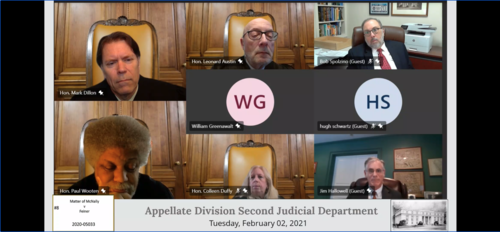Court Hears Feiner’s Appeal on Edgemont’s Right to Vote
Yesterday, a four-judge panel at the New York State Appellate Division (Second Department) heard oral arguments in the matter of Edgemont’s second petition seeking a vote, as ordered by the lower court, on whether Edgemont should incorporate into a village.
Jim Hallowell, Edgemont resident and partner at Gibson, Dunn & Crutcher, appearing pro bono in support of Edgemont’s right to a vote, defended the legal sufficiency of the petition against the appeal by Greenburgh Town Supervisor Paul Feiner and other objectors.
Several of Feiner’s objections were discussed at the oral argument:
Feiner’s counsel argued that Feiner was entitled to throw out hundreds of signatures as “stale,” because the signers might have changed their minds during the interim. Justice Dillon questioned that assertion, suggesting that “if a person changes their mind later after having signed, their remedy is to vote against” the referendum, rather than preclude the vote entirely.
Feiner’s counsel argued that a petition is legally invalid unless it identifies every minor child in the proposed village by name and address, even if some children’s parents will not consent to such identification in a public document. Justice Austin noted the practical difficulties of that position, asking: “If a parent doesn’t want to give the name and age of their child, does that mean that one is forever precluded from filing an appropriate petition?”
Addressing Feiner’s purported inability to identify the borders of the proposed village despite that fact that it will be coterminous with the Greenville Fire District, an area that is specifically taxed by the Town itself, Jim Hallowell responded: “The appellants have made reference to alleged overlaps…[and] have made the argument that if there is any overlap at all, that there simply cannot be an election held and therefore this village incorporation petition can’t go forward. The Greenville Fire District has existed since 1923 and since 1923 it has held annual elections for its fire commissioners without incident.”
Jim concluded by noting that the burden of proof is on the objectors because “village incorporation petitions are supposed to be the kind of thing that ordinary citizens can pull together and submit to a Town Supervisor.” Amen to that.
To watch a replay of the hearing, click here. The matter of McNally v. Feiner is the eighth case on the docket. Robert Spolzino starts his arguments at the 46:51 mark. Edgemont resident and petition objector Hugh Schwartz, who maintains an anti-incorporation blog (available here), represented himself before the court at 1:00:46. William Greenawalt, beginning at 1:13:25, also spoke on behalf of several other objectors (including Edgemont resident Michael Schwartz, a steering committee member of an anti-incorporation group; website here). The EIC’s website is edgemont2021.org.
Jim Hallowell’s remarks begin at 1:27:03.
We look forward to the court’s decision, which may be issued within the next 60 days. As to next steps:
If the Appellate Division affirms the lower court’s ruling that Feiner’s rejection of the petition was illegal, unlawful, and contrary to the weight of evidence, an election would be ordered within 40 days. However, the Town would have the right to seek permission to appeal to the New York Court of Appeals (New York’s highest court), and the vote would be delayed until the Court of Appeals either refuses to hear the appeal or reverses the Appellate Division’s ruling.
If the ruling is unfavorable to us, we would have the same right to seek permission to appeal to the Court of Appeals (as we did for the first petition).
(Note: The Court of Appeals can decline to hear any appeal from this decision, regardless of who wins. It could take upwards of 90 days to hear from the Court of Appeals one way or another.)
In the meantime, our own State Assemblyman Tom Abinanti continues to push anti-incorporation legislation in a clear attempt to outrace the Edgemont decision. We are keeping a close eye on that.
We thank Jim and his talented associates at Gibson Dunn for conveying our position on appeal so clearly, skillfully, and passionately. We remain cautiously optimistic that we will vote on our preferred form of self-governance in the near future.
If you are new to incorporation, we encourage you to take a break from shoveling and read this background article.
Best,
The EIC





